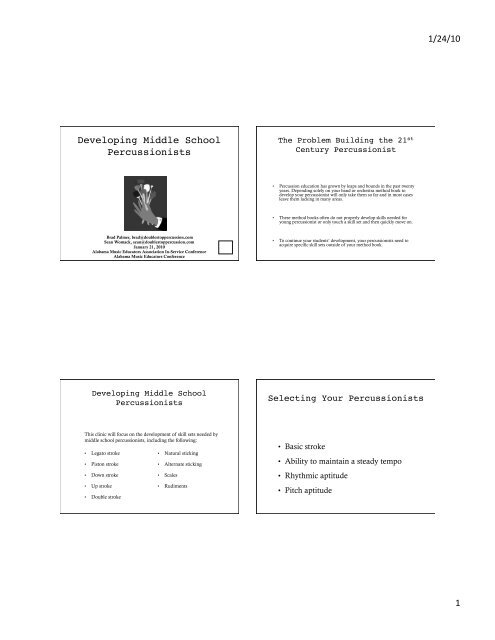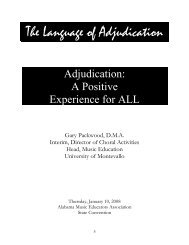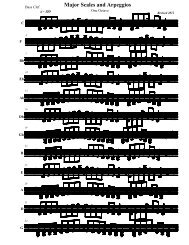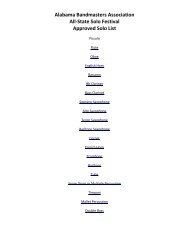AMEA Presentation 1.0.pptx - Alabama Music Educators Association
AMEA Presentation 1.0.pptx - Alabama Music Educators Association
AMEA Presentation 1.0.pptx - Alabama Music Educators Association
You also want an ePaper? Increase the reach of your titles
YUMPU automatically turns print PDFs into web optimized ePapers that Google loves.
Developing Middle School<br />
Percussionists!<br />
Brad Palmer, brad@doublestoppercussion.com<br />
Sean Womack, sean@doublestoppercussion.com<br />
January 21, 2010<br />
<strong>Alabama</strong> <strong>Music</strong> <strong>Educators</strong> <strong>Association</strong> In-Service Conference<br />
<strong>Alabama</strong> <strong>Music</strong> <strong>Educators</strong> Conference<br />
Developing Middle School<br />
Percussionists!<br />
This clinic will focus on the development of skill sets needed by<br />
middle school percussionists, including the following:<br />
• Legato stroke<br />
• Piston stroke<br />
• Down stroke<br />
• Up stroke<br />
• Double stroke<br />
• Natural sticking<br />
• Alternate sticking<br />
• Scales<br />
• Rudiments<br />
�"<br />
The Problem Building the 21 st<br />
Century Percussionist!<br />
• Percussion education has grown by leaps and bounds in the past twenty<br />
years. Depending solely on your band or orchestra method book to<br />
develop your percussionist will only take them so far and in most cases<br />
leave them lacking in many areas.<br />
• These method books often do not properly develop skills needed for<br />
young percussionist or only touch a skill set and then quickly move on.<br />
• To continue your students’ development, your percussionists need to<br />
acquire specific skill sets outside of your method book.<br />
Selecting Your Percussionists!<br />
• Basic stroke<br />
• Ability to maintain a steady tempo<br />
• Rhythmic aptitude<br />
• Pitch aptitude<br />
1/24/10<br />
1
• The fulcrum<br />
The Grip !<br />
• Thumb and first finger on the fulcrum<br />
• Fingers gently wrap around the stick/mallet,<br />
but remain in contact with the stick<br />
• No space between fingers or the stick<br />
Legato Stroke!<br />
• Legato - in a smooth flowing manner, without breaks between<br />
notes<br />
• This stroke should have a full range of motion, starting from the<br />
wrist. The fingers should remain in contact with the stick at all<br />
times. This is the most basic and one of the most utilized strokes<br />
percussionists use.<br />
The Stance!<br />
• Drum/Keyboard waist height<br />
• 6-12 inches away from the instrument<br />
• Beads together in the center of head/bar<br />
• 90 degree angle<br />
Starting the Legato Stroke!<br />
• R R R R R R R R L L L L L L L L<br />
• R R R R L L L L R R R R L L L L<br />
• R R L L R R L L R R L L<br />
• R L R L R L R L R L R L<br />
• R L R R L R L L R L R R L R L L<br />
• These and many other sticking patterns can be found in “Stick Control”<br />
by George L. Stone.<br />
• These sticking patterns can be developed and used in middle school, as<br />
well as throughout high school.<br />
1/24/10<br />
2
Continuing the Legato Stroke!<br />
Snare Drum<br />
Legato Strokes<br />
�<br />
�<br />
��<br />
� � � � � � � � � � � � � � �<br />
R R R R R R R R L L L L L L L L<br />
���������<br />
�������� � � �<br />
R R R R R R R R L L L L L L L L R<br />
The Piston Stroke!<br />
The piston stroke is utilized on keyboard instruments and is<br />
similar to the legato stroke. The piston stroke starts at the<br />
top and returns to the top, which creates efficient movement<br />
across the keyboard and allows for a fluid stroke.<br />
Snare Drum<br />
Legatos with 16 th Notes!<br />
�<br />
�<br />
���������������������������������<br />
R R R R R R R R L L L L L L L L R R R R R R R R L L L L L L L L<br />
R L R L Sim.<br />
Legato Stroke adding 16th notes<br />
����������������������������������<br />
�� The Piston Stroke!<br />
The Piston Stroke<br />
�<br />
���<br />
� � � � � � � � � � � � � � �<br />
� � � � � � � � � � � � � � � �<br />
�<br />
� � � � � � � � � � � � � � � � � � � � � � �� ��<br />
� � � � � � � � � �<br />
1/24/10<br />
3
Basic Timing Elements!<br />
• Once students begin to understand the concept of legato and<br />
piston strokes, apply those ideas to basic timing exercises.<br />
• These exercises will help percussionists develop a stronger<br />
rhythmic vocabulary.<br />
• In addition, they will help students understand natural and<br />
alternate stickings.<br />
Combining 16 th and 8 th Notes <br />
<strong>Alabama</strong> Texas!<br />
�<br />
���������������������������<br />
� �<br />
3<br />
1<br />
<strong>Alabama</strong> Texas<br />
R L R L R L R L R L R L R L R L R L R L R L R L R<br />
�������������<br />
������������ � � �<br />
R L R L R L R L R L R L R L R L R L R L R L R L R<br />
Snare Drum<br />
Keyboard<br />
8 th Note Timing!<br />
�<br />
�<br />
�<br />
���������������<br />
������������ � ���� �<br />
R L R L R L R L R L R R L R R L R L R L R L R L L R L L<br />
�<br />
��<br />
�<br />
�������������� ���������� �� � �� �� �<br />
R L R L R L R L<br />
8th Note Timing<br />
R L R R L R<br />
R L R L R L R L<br />
R L L R L L<br />
�<br />
�������������������������<br />
� ���� � ���� �<br />
R L R L R L R L R R L R R L R L R L R L R L L R L L R L R<br />
��<br />
������������������������ ���� ����<br />
� �<br />
�<br />
R L R L R L R L R R L R R L R L R L R L R L L R L L R L R<br />
Natural Sticking and <br />
Alternate Sticking!<br />
• Natural sticking is based on hands playing on a specific beat,<br />
which allows the rhythm patterns to be played with the same<br />
sticking throughout a given passage.<br />
• Alternate sticking simply alternates hands through a specific<br />
rhythmic passage while moving back and forth from right to left<br />
hand.<br />
1/24/10<br />
4
Natural and Alternate <br />
Sticking Examples!<br />
Natural Sticking<br />
�<br />
������������������<br />
������������<br />
R L R L R L R L R L R L R L R L R L R R L R R L R R L R<br />
Alternate Sticking<br />
�����������������<br />
������������<br />
R L R L R L R L R L R L R L R L R L R L R L R L R L R L<br />
Down Strokes, Up Strokes, and<br />
Staccato Strokes!<br />
• A down stroke is used to stop the stick at the bottom. It has<br />
a similar range of motion from the wrist, but uses the ring<br />
and pinky fingers to stop the stick and not allow it to<br />
rebound.<br />
• An up stroke starts from the bottom and stops at the top of<br />
the stroke. It has a similar range of motion and comes from<br />
the wrist.<br />
• A staccato stroke, also called a tap, is played low, short, and<br />
detached.<br />
Snare Drum<br />
Keyboard<br />
5<br />
16th Note Timing!<br />
16th Note Timing<br />
� �<br />
���<br />
� � � � � � � � � � � � � � � ��� ��� ��� ��� ���������������� � � �� � �� � �� � �<br />
R L R L R L R L R L R L R L R L R L R R L R R L R R L R R L R L R L R L R L R L R L R L R L L R L L R L L R L L<br />
�<br />
��<br />
�<br />
� � � � � � � � � � � � � � � � ��� ��� ��� ��� ���������������� � � �� � �� � �� � �<br />
R L R L R L R L R L R L R L R L R L R R L R R L R R L R<br />
R L R L R L R L R L R L R L R L R L L R L L R L L R L L<br />
�<br />
�����������������<br />
� ��� ��� ��� �� ���������������� ���� ���� ���� ���� � �� R L R L R L R L R L R L R L R L R R L R R L R R L R R L R L R L R L R L R L R L R L R L L R L L R L L R L L R L R<br />
��<br />
���������������� � ��� ��� ��� �� ���������������� ���������������� � ��<br />
R L R L R L R L R L R L R L R L R R L R R L R R L R R L R L R L R L R L R L R L R L R L L R L L R L L R L L R L R<br />
Accents and Taps!<br />
Accents and taps use down, up, and staccato strokes to create two<br />
different heights. These exercises should also be developed in 8 th<br />
notes, 16 th notes, and triplets.<br />
Basic Accent and Taps<br />
� �<br />
�<br />
�<br />
��<br />
� � � � � � � � � � � � � � �<br />
R L<br />
� � �<br />
��<br />
� � � � � � � � � � � � � � � � � �<br />
R L R<br />
1/24/10<br />
5
Countdown!<br />
Countdown<br />
� � � � � �<br />
�<br />
�<br />
� ���������������� �<br />
� �������������� �<br />
� ������������ �<br />
�<br />
R L R L R L<br />
� � � � � � � � � � � �<br />
�<br />
�<br />
�<br />
�<br />
�<br />
�<br />
�<br />
� �<br />
� �<br />
�<br />
�<br />
� ���������� �������� ������ ���� � �<br />
� � � ����<br />
R L R L R L R L R L R L<br />
� � � � � � � �<br />
�<br />
�<br />
�<br />
�<br />
�<br />
�<br />
�<br />
�<br />
�<br />
� ������ �������� ���������� ������������ �<br />
R L R L R L R L<br />
� � � � �<br />
�<br />
�<br />
�<br />
� �������������� � �������������������<br />
R L R L R<br />
Double Stroke!<br />
• The double stroke is used to create rolls and drags. This<br />
stroke is similar to the legato in its range of motion and<br />
rebound. It differs in that the player must use the back two<br />
fingers, ring finger and pinky, as well as the wrist, to get the<br />
second note to sound.<br />
• A good double stroke will come from one motion and create<br />
two even notes.<br />
4-2-1 Sequence with 16 th and<br />
Triplet Groupings!<br />
16th Note Accent Pattern<br />
� � � � � � � �<br />
�<br />
� ��<br />
� � � � � � � � � � � � � � � � � � � � � � � � � � � � � � �<br />
�<br />
R L R L R L R L R L R L R L R L R L R L R L R L R L R L R L R L<br />
� � � � � � � � �<br />
� � � � � � � � � � � � � � � � � � � � � � � � � � � � � � � � � �� R L R L R L R L R L R L R L R L R L R L R L R L R L R L R L R L R<br />
Triplet Accent Pattern<br />
� � � � � � �<br />
�<br />
� ��<br />
� � � � � � � � � � � � � � � � � �� ��<br />
R L R L R L R L R L R L R L R L R L R<br />
Double Strokes Using <br />
<strong>Alabama</strong> Texas!<br />
<strong>Alabama</strong> Texas<br />
2<br />
�<br />
��<br />
� ����� � ����� � � � ��������� ��<br />
R L R R L L R L R R L L R L R L R R L L R R L L R<br />
4<br />
��<br />
����� � ����� � ��������� � � � �� �<br />
R R L L R L R R L L R L R R L L R R L L R L R L R<br />
1/24/10<br />
� �<br />
6
Combining the Skill Sets!<br />
By combining the skill sets discussed previously, we can see how<br />
these combinations are used throughout the 40 Percussive Arts<br />
Society International Rudiments.<br />
Paradiddle<br />
Diddle Rudiments!<br />
Diddle Rudiments<br />
� � � �<br />
�<br />
�<br />
��<br />
� � � � � � � � � � � � � � � ��<br />
�<br />
R L R R L R L L R L R R L R L L<br />
Double Paradiddle<br />
� � � �<br />
��<br />
��<br />
������������������������<br />
R L R L R R L R L R L L R L R L R R L R L R L L<br />
Triple Paradiddle<br />
� � � �<br />
�<br />
�<br />
��<br />
� �������������������������������� �<br />
R L R L R L R R L R L R L R L L R L R L R L R R L R L R L R L L<br />
Paradiddle Diddle<br />
� � � �<br />
��<br />
��<br />
������������������������<br />
R L R R L L R L R R L L R L R R L L R L R R L L<br />
Single 4<br />
3 3 3 3<br />
Roll Rudiments!<br />
Roll Rudiments<br />
Single 7<br />
6 6<br />
�<br />
���<br />
� � � � � � � � � � � � � � � � � � � � � � � � � � � � �<br />
R L R L R L R L R L R L R L R L R L R L R L R R L R L R L R<br />
5 Stroke Roll<br />
9 Stroke Roll<br />
� � � � � � � �<br />
��<br />
� � � � � � � � � � � � � � � � � � � � � � � � � � � � � � � � � � � � � � � � � � �<br />
R L R L R L R L R L R L R L R L R L R L R L R L R L R L R L R L<br />
17 Stroke Roll<br />
� � � �<br />
����������<br />
� ��������� � ��� �� �� �� �� �� ��� � � ��� �� �� �� �� �� ��� � �<br />
R L R L R L R L R L R L R L R L R L R L R L R L R L R L R L R L R L R L<br />
Flam<br />
Flam Rudiments!<br />
Flam Rudiments<br />
� � � �<br />
�<br />
��<br />
��<br />
�� �<br />
�� � �<br />
�� � �<br />
�� �<br />
R L R L<br />
Flam Tap<br />
� � � �<br />
�<br />
��<br />
� � � � � � �<br />
� � � � �<br />
�� � � � �<br />
R R L L R R L L<br />
Flam Accent<br />
� 3 � 3 � 3 � 3<br />
�<br />
��<br />
� � � �<br />
� � � �<br />
�� � � � �<br />
�� � � � � � �<br />
R L R L R L R L R L R L<br />
1/24/10<br />
7
Single Drag<br />
Drag Rudiments!<br />
Drag Rudiments<br />
� � � �<br />
��<br />
� � �<br />
� ����<br />
��� ��� ���<br />
�<br />
LL R RR L LL R RR L<br />
Single Ratamacue<br />
�<br />
��<br />
3 � 3 � 3 � 3 �<br />
�<br />
��<br />
�<br />
��<br />
�<br />
��<br />
� � � �<br />
� � � �<br />
� � � � � � � �<br />
LL R L R L RR L R L R LL R L R L RR L R L R<br />
Thank You to the Following!<br />
• Jeff Atkins, Kim Bain, Dr. Mark Foster, Mike Holmes, Heather Holmes, Brandon Peters, and Mark Sosnowchik, Jerell Horton, Heather<br />
Palmer, Sara Womack<br />
• Geaton Thorne, Joseph Pewitt, Austin Blain, Zack Downing, Joseph Wendel,, Zach Zedekni, Margo King, Trey Hodges, Todd Gwaltney,<br />
Rhett Randolph, Austin McNamee, Josh Littlefield, Sam Pruitt, Alaina Barham, Patric Taylor, Logan Risner, Demarcus Kelly<br />
• The all the students from Pizitz, Oak Mountain, Mountain Brook, and Hewitt-Trussville Middle Schools<br />
• Neal Flum, Beth Gottlieb, and the University of <strong>Alabama</strong> School of <strong>Music</strong><br />
• Innovative Percussion Sticks and Mallets<br />
• Pearl Drums<br />
• Adams <strong>Music</strong>al Instruments<br />
• Evans Drumheads<br />
• <strong>Alabama</strong> <strong>Music</strong> <strong>Educators</strong> <strong>Association</strong><br />
• Garry Taylor<br />
Applying Skills Sets in the<br />
Classroom!<br />
• Daily warm-up<br />
• Technique development<br />
• Sectionals<br />
1/24/10<br />
8







